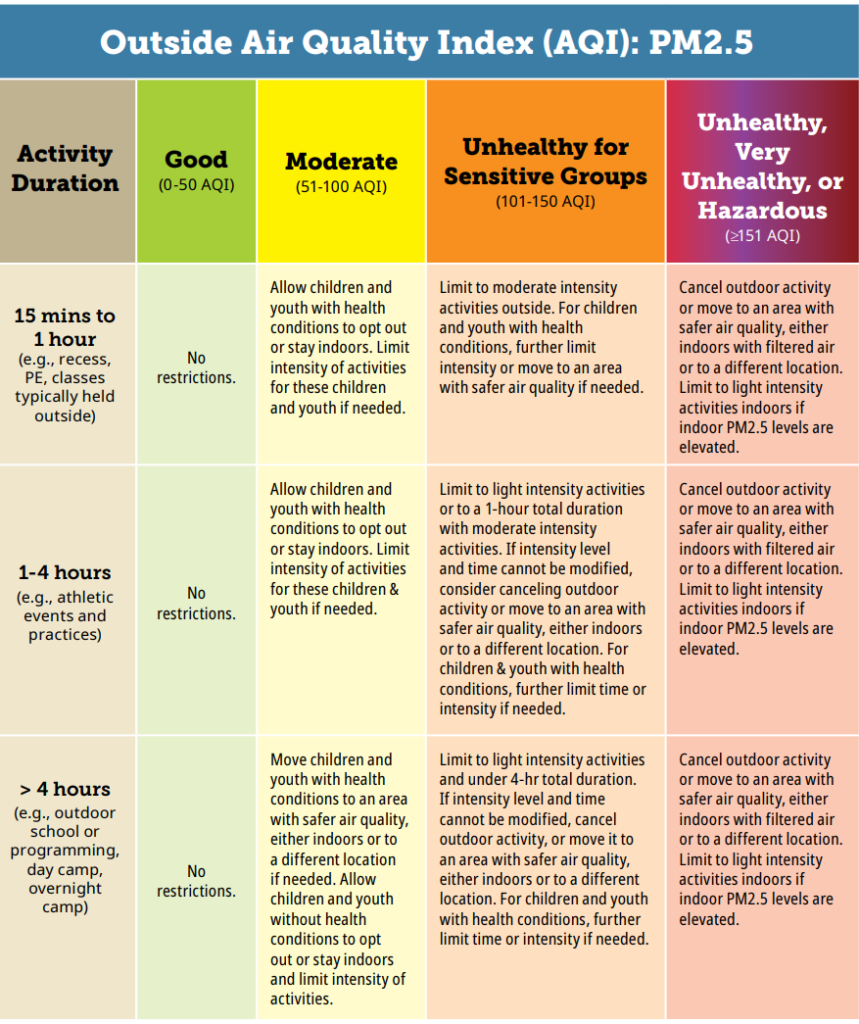
The Air Quality Index (AQI) measures the air quality of a specific area and is used to provide guidance for outdoor activity. You can view the interactive map for Washington AQI here. Air quality can be impacted for many reasons, including pollen, smoke or pollution. Even if the fire is not very close, smoke can be an issue. Indoor air quality can be also be impacted by cleaning supplies, smoking/vaping or wood heating.
The EPA’s Air Quality Index (AQI) was released in 1999. It was created to provide a standardized way of looking at five major air pollutants – carbon monoxide, particulate matter (PM2.5 and PM10), sulfur dioxide, nitrogen dioxide, and ozone. Of these five pollutants, PM2.5 has become the most closely monitored over the past few years. The ‘2.5’ refers to the size of the particulate matter – 2.5 microns or smaller. As a point of comparison, a human hair is more than 30x larger in diameter than these fine particles.
In addition to causing irritation to the eyes, nose and throat, inhaled PM2.5 travels deep into the lungs, where they aggravate existing lung problems, such as asthma, chronic bronchitis and COPD. They are small enough to pass from the lungs into the bloodstream and be transported throughout the body, serving as source of inflammation. Short-term exposures have been associated with a number of health effects including increased hospital admissions for heart or lung causes, especially in infants and children less than 5 years of age, and older adults with preexisting heart or lung diseases. The research is growing on the long-term (months to years) exposure to PM2.5, to include premature death, particularly in people who have chronic heart or lung diseases, and reduced lung function growth in children.
Visit Airnow.gov for up-to-date information about the local AQI

Air Filters
When the air quality isn’t very good, it is important to also consider indoor air quality. You can purchase HEPA air filters or you can make your own using a box fan. See the directions for a DIY air filter here and here.
Effects from wildfire smoke
You may experience:
- burning eyes
- coughing
- throat or sinus irritation
- running nose
- headaches
- fatigue
- wheezing/shortness of breath
- irregular or fast heartbeat
- chest pain
Infants, young children, pregnant women, people with asthma and the elderly may experience more severe side effects from the smoke and should take extra precautions to stay indoors as much as possible.
If your symptoms are severe, seek medical attention. Staying indoors, using an air filter and keeping doors and windows closed can help limit exposure. You can also wear an N95 mask or respirator if you need to be outside. Avoid adding to indoor air pollution by avoiding candles, incents or smoking/vaping if smoke is also impacting indoor air.
Drink lots of water and stay hydrated.
School activities and smoke- updated July 2023
In order to keep all children safe and healthy, schools and childcare facilities may cancel or reschedule outdoor activities if the air quality is unsafe. Once the AQI reaches 101, schools may begin to cancel athletic activities (games or practice). When the AQI is above 150 it is strong recommended that all outdoor activities including PE, recess and athletic events be canceled, rescheduled or moved indoors. Indoor activity may also be limited if the indoor air quality is poor.
Factors that will be weighed when considering canceling outdoor activities, including school sports, include the forecast for unhealthy level, options to relocate or reschedule the event, and other weather conditions, such as excessive heat and humidity.

Inversions
Temperature inversions happen when the air closer to the earth is colder than the air higher in the atmosphere. Usually, the air gets colder the higher you go. When the air gets warmer as you go up, the colder air gets “trapped”. The inversion makes it harder for air pollutants to rise and negatively impacts air quality. Fog or smog can indicate a temperature inversion. Wind, a rainstorm or the temperature rising can clear an inversion. Valleys and coastal areas are more likely to experience a weather inversion but they can happen anywhere. An inversion can cause respiratory symptoms such as shortness of breath, chest pain or asthma attacks. Stay indoors and reduce outdoor exposure as needed.
At risk populations
Poor air quality can be especially dangerous for pregnant people, babies, those over 65 and anyone with asthma, heart disease or lung disease. Individuals more at risk may consider reducing outdoor activities at the “moderate” or “unhealthy for sensitive groups” levels.
Consider keeping extra food, water and at least 3 days of medication on hand in case you are unable to leave your home due to poor air quality.
If you have trouble breathing contact your healthcare provider or call 911.